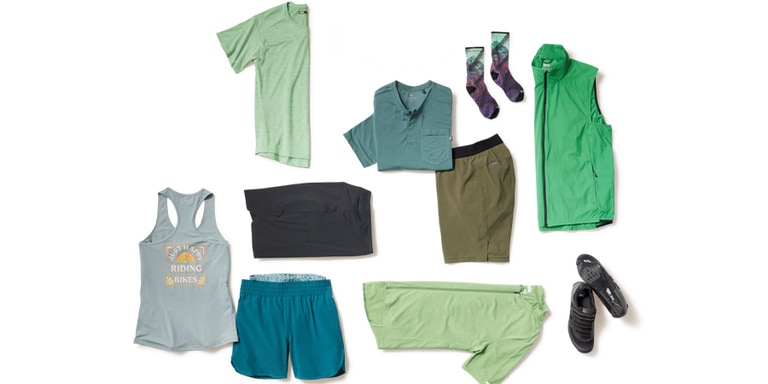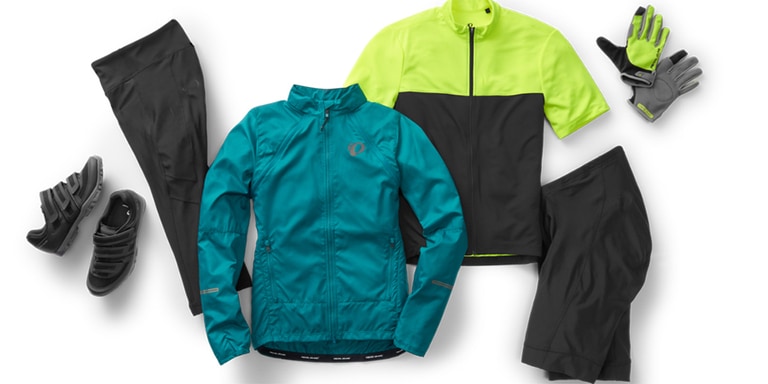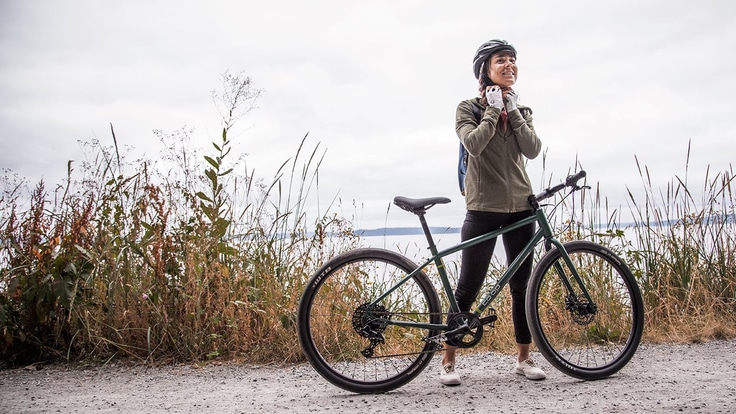Whether you're brand new to cycling or rediscovering the joys of two-wheel adventuring after a few years, you might be wondering what to wear on a bike ride. For starters, you don't have to run out and buy a bunch of cycle clothing to enjoy riding, nor do you have to buy stuff to look cool. (Feeling cool is OK, though, especially in summer.)
Bike-specific clothing can certainly help improve your riding comfort and performance. Also important: Bike clothing can improve your visibility to motorists. But not all bike clothing is designed to call attention to you. Because the "spandex look" isn't for everyone, a lot of brands are designing bike clothes that can double as streetwear.
Note: This article focuses on general cycling clothing strategies. Check out our separate article on What to Wear Mountain Biking to learn about clothing options for that type of riding.
Repurpose Other Outdoor or Athletic Clothing
You can save on bike clothing by wearing almost any comfortable outdoor or athletic clothing (think breathable, moisture-wicking) when you ride, though you'll want to add some reflective wear or reflective elements if you do. This is less of an issue where vehicles aren't around, like on a mountain-bike-only trail.
Reflectivity is especially important on jackets and pants, which you'll wear in colder, darker weather. How much reflectivity? Generally, you want a driver approaching from any direction to encounter a reflective element or a bike light. When in doubt, more visibility is always better.
Bike Helmet
While not exactly bike clothing, a helmet is something every cyclist needs to wear. You can choose a helmet based on the type of riding you do, but any bike helmet can work for any type of riding. The most important thing is to get one that fits well. Learn more in How to Choose a Bike Helmet. (Helmet designs have also evolved, so you have more stylish options available, though none solve the issue of helmet hair.)
Sunglasses: Eye protection, both from windblown debris and UV rays, is important, so make sure you have a good pair. Wraparound sunglasses, which offer extended coverage, work well for cycling. Learn more in How to Choose Sunglasses. If you have a mountain bike helmet, you can get goggles to wear with it.

Bike Shorts
Most bike shorts feature stretch fabrics for ease of movement while pedaling. Bike shorts tend to be cut longer than casual shorts, and some bike shorts might have gripper elastic at the leg openings to keep them in place as you pedal.
The chamois: The most important—and complex—part of bike shorts is the synthetic "chamois," (pronounced "sha-mee"), a padded crotch piece that also reduces friction and wicks away moisture. Chamois come in a variety of shapes, thicknesses and materials. Gel chamois, found more often in mountain bike shorts, cushion well but are less breathable than non-gel styles. A few riders don't like the feel of any chamois, so you can try riding with or without one to decide which is more comfortable for you.
Cycling underwear (liner shorts): Like underwear for other high-exertion activities, cycling underwear features flexible fabrics and wicking materials that dry quickly. In addition, almost all cycling underwear has a built-in chamois to make your ride more comfortable. Liner shorts can be worn under your favorite pants or shorts, making any bottoms cycle-ready—a strategy that can save you a few dollars.
Other styles of bike shorts:
- Skorts: A mashup of shorts and skirt, "skorts" are an alternative style that pairs stretch shorts with an outer skirt. You can also find cycling skirts designed to be worn over your own cycling shorts or cycling underwear.
- Bib shorts: Bibs are popular with racers because, unlike with shorts, there's no waistband that can restrict breathing. But there's no rule that says a casual rider can't wear bibs simply to be more comfortable.
- Mountain bike shorts: Sometimes called "baggies" or "double shorts," they have loose outer shorts paired with stretch liner shorts that have built-in chamois. Many liner shorts can also be detached and worn separately or with other bike shorts. Mountain bike shorts typically have durable outer fabric and lots of pockets, and have few, if any, reflective elements.

Bike Pants, Tights and Warmers
An alternative to bike shorts, especially for cooler temperatures, many bike pants and tights also come with a built-in chamois. Front panels might offer wind protection, and some pants might be fully waterproof and windproof. Tights tend to be less weather protective but more aerodynamic.
Commuter/casual pants: Some cycling pants look like streetwear so riders can instantly blend in at any urban destination. These styles have cycling features like stretch fabric and a cuff on the chain-side pant leg that rolls up to reveal reflective trim—and to prevent the cuff from getting caught in the chain. But they're stylish enough that you can wear them off the bike.
Bike Jerseys
All bike jerseys tend to be stretchy (especially road jerseys), breathable, moisture-wicking and quick-drying. Most road jerseys will have a form-fitting (aerodynamic) cut that distinguishes them from mountain bike jerseys. You can also find many casual shirt styles that looking nothing like traditional bike jerseys.
Other jersey features include:
- Tall or flip-up collar to shade your neck from UV rays.
- Front zipper for ventilation as your exertion level rises.
- Shoulders cut wider for arms-forward comfort.
- Back pockets for easy on-the-go access.
- Longer cut in back for coverage when you lean forward on the bike.
- Reflective trim or material for night riding.
Additional jersey features for cold weather:
- Long sleeves for more warmth and coverage.
- Denser, heavier fabric weaves and a brushed lining to add insulation.
Cycling Arm and Leg Warmers
These handy tweener-weather cycling accessories can be used on the fly to offer added warmth for legs and arms. Adding lightweight arm and leg warmers is also a great way to protect arms and legs from UV rays on hot days.
Cycling Jackets
The top considerations in a cycling jacket are whether it will block the wind and whether it will keep you dry. Most jackets do both tasks to some degree, so think first about the likelihood of rain on your rides. Note, too, that some jackets offer more warmth than others, which will be a concern if you ride in a colder climate or in the winter months.
How much rain do you anticipate? For serious rain protection, a jacket that is waterproof will offer more protection than a water-resistant one. Note, too, that you'll likely need waterproof AND breathable technologies (like GORE-TEX® fabrics) for a high-exertion activity like riding.
If rain, especially light rain, is only an occasional concern, then a water-resistant jacket is fine; it offers as good or better breathability than more expensive waterproof/breathable jackets.
Hoods: Some jackets have none, while others have a detachable or stowable hood. If you choose a jacket with a "helmet-compatible" hood, try it with your helmet to see how it fits and whether it restricts visibility.
Zip-off sleeves: Convertible bike jackets offer this handy feature that lets you change your jacket into a vest if the weather eases up.
How cold will it be? The jacket you want for winter riding in Chicago is different than one for winter riding in Phoenix. Warmer jackets will have thicker material and often a brushed liner for added insulation. But don't overdress because you'll warm up from exertion as you ride. You can also wear a warm layer underneath any jacket. For more cold-weather advice, read Tips for Winter Bicycling.
For tips on jacket choice, read Staff Picks: The Best Cycling Jackets.
Bike Shoes
The bike shoes you need depend on the type of pedals your bike has. If it has basic platform pedals, then you could wear pretty much any type of shoes. However, cycling shoes, even a basic pair, have much stiffer soles than street shoes or even hiking footwear. That sole stiffness translates to better power transfer when you pedal.
If your bike has clipless pedals, then you definitely need bike shoes with soles that can engage with those pedals. That means it's critical that your shoes are compatible with your style of pedals. Learn more by reading How to Choose Bike Shoes and How to Choose Bike Pedals.
Shoe covers: For wet or rainy rides, toe covers (which cover the shoe from arch to toe) or shoe covers (which cover the entire shoe and part of the ankle) are a great way to keep feet warmer and drier. For really stormy weather, consider a pair of waterproof cycling socks.
Bike Socks
Your feet sweat a lot when you're pedaling. In cold weather, this can lead to cold feet. In hot weather, that can mean blisters. So it's best if your socks are made of synthetic materials like polyesters or nylons that help wick away perspiration. Merino wool is a natural material that offers comparable performance. Avoid cotton socks for all but light workouts.
You can use any type of performance socks for cycling, though bike socks have subtle details that distinguish them, like thinner material to allow a bike shoe to fit more snug (aiding power transfer to pedals). For more details, read Do I Really Need Cycling Socks?
Accessory Items
Caps and skullcaps: These add insulation to your winter rides; a headband is another option to help keep your ears warm.
Gloves: Cycling gloves feature padding that helps absorb road and trail vibrations, so they are a better option than repurposing other gloves. Most bike gloves have a leather or synthetic-leather palm and moisture-absorbing terry cloth patch for dabbing sweat or a runny nose.
In summer, fingerless bike gloves are popular. For cold-weather rides, a pair of wicking, breathable, full-finger bike gloves are a must. Many full-finger gloves also offer protection against the wind and rain. For even greater warmth, consider using thin liner gloves inside your other gloves. Another option for severe cold is a pair of "pogies," an accessory that lets you slide your hand inside to grip the handlebar.
Related Articles
Do I Really Need Cycling Socks?
Staff Picks: Best Cycling Jackets

